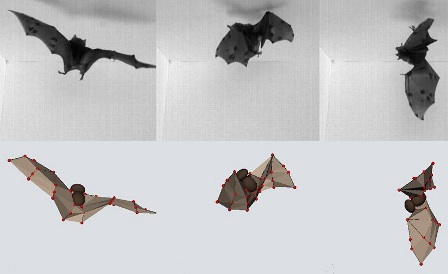- Series:Animales, Animals, Transcript English
Psalm 40:4
“Blessed is that man that maketh the LORD his trust, and respecteth not the proud, nor such as turn aside to lies.”
Most bats, as you know, hang from their feet on the ceilings of caves. But not until recently did scientists know how bats switched from flying right-side-up to landing upside down in the space of a half second. Scientists assumed that bats used some kind of aerodynamic trick to pull this off. But the bats’ mid-flight flip has almost nothing to do with air flow.
 According to a new study in PLOS Biology, researchers took high-speed videos of bats as they landed upside down on a gauze net attached to the ceiling. The researchers were surprised to see the bats manipulating the inertia in their bodies to execute the flip just before landing. This is similar to the way pirouetting figure skaters speed up or slow down their rotation by pulling their arms closer to their body.
According to a new study in PLOS Biology, researchers took high-speed videos of bats as they landed upside down on a gauze net attached to the ceiling. The researchers were surprised to see the bats manipulating the inertia in their bodies to execute the flip just before landing. This is similar to the way pirouetting figure skaters speed up or slow down their rotation by pulling their arms closer to their body.
“It never would have occurred to me that aerodynamics would play such a small role in landing,” said evolutionary biologist Sharon Swartz. “I always think of flight as a primarily aerodynamic phenomenon. Wings are aerodynamic organs, and landing seems so obviously to be a flight behavior.”
Once again, we see that “obvious” answers can lead scientists astray. Evolutionary biologists in particular think it’s obvious that animal behaviors are the result of evolution. They should look at solutions that aren’t so obvious. If they did, they might learn more about the creatures they are studying as well as the One who created them.
Prayer: Heavenly Father, You have given Your creatures everything they need to live the life You planned for them, but You have done so much more for me by sending Your Son to die for my sins. In Jesus’ Name. Amen.
Author: Steven J. Schwartz
Ref: N. Akpan, “Bats flip like Tony Hawk to land upside down,” PBS Newshour, 11/16/15. Photo: High-speed video and computer models show that bats use inertia to make acrobatic flips and land upside down. Photo by Bergou AJ et al. (2015) Courtesy of PLoS Biology. (Fair Use)
© 2016 Creation Moments. All rights reserved.
